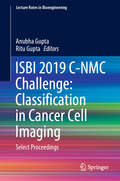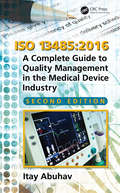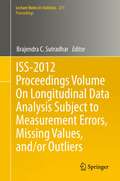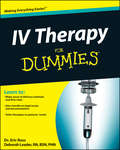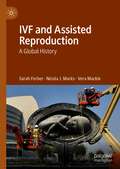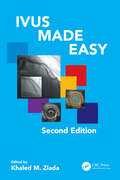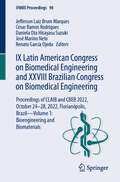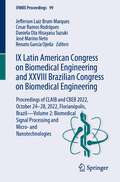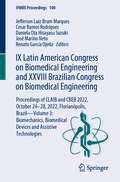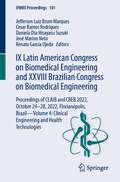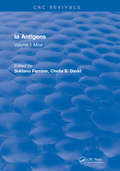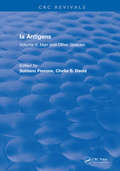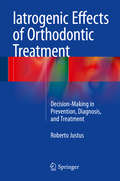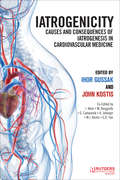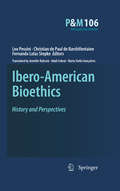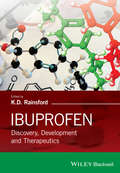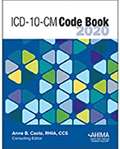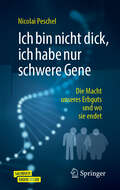- Table View
- List View
ISBI 2019 C-NMC Challenge: Select Proceedings (Lecture Notes in Bioengineering)
by Anubha Gupta Ritu GuptaThis book comprises select peer-reviewed proceedings of the medical challenge - C-NMC challenge: Classification of normal versus malignant cells in B-ALL white blood cancer microscopic images. The challenge was run as part of the IEEE International Symposium on Biomedical Imaging (IEEE ISBI) 2019 held at Venice, Italy in April 2019. Cell classification via image processing has recently gained interest from the point of view of building computer-assisted diagnostic tools for blood disorders such as leukaemia. In order to arrive at a conclusive decision on disease diagnosis and degree of progression, it is very important to identify malignant cells with high accuracy. Computer-assisted tools can be very helpful in automating the process of cell segmentation and identification because morphologically both cell types appear similar. This particular challenge was run on a curated data set of more than 14000 cell images of very high quality. More than 200 international teams participated in the challenge. This book covers various solutions using machine learning and deep learning approaches. The book will prove useful for academics, researchers, and professionals interested in building low-cost automated diagnostic tools for cancer diagnosis and treatment.
ISO 13485: A Complete Guide to Quality Management in the Medical Device Industry, Second Edition
by Itay AbuhavSummary: This book provides valuable, effective guidance for understanding, interpreting and implementing ISO 13485:2016 standard requirements. Despite its more than 800-page length, the author has specifically designed its contents to maximize usability for the reader with a table of contents identical to that of the ISO standard itself, which enables easy navigation and orientation. Pragmatic in style and down to earth in tone, this book draws real-life examples and case-studies from the author’s many years of experience in consulting to illustrate even the most complex of ISO 13485:2016 standard requirements and their implementation. Identifying relevant requirements and how they harmonize with quality management systems, developing processes for design and development, as well as product realization and validation are just a few of the issues covered in-depth by this publication. In addition, the author constantly reviews the distinctive characteristics and aspects of the medical device manufacturing industry, so that the reader can also appreciate the subject of this book in an everyday context. Features: A pragmatic and down to earth approach towards the reader’s understanding of ISO 13485:2016 standard requirements implementation. Uses examples and cases from real-life based on the author’s many years of experience in quality management. A table of contents structured identically to that of ISO 13485:2016 itself, allowing easier navigation and orientation for the reader. Emphasises guidance for ISO 13495:2016 standard requirements which are difficult to interpret and implement Constantly reviews the aspect of medical device industry characteristics and distinctive so the reader can reflect the content with its daily work.
ISS-2012 Proceedings Volume On Longitudinal Data Analysis Subject to Measurement Errors, Missing Values, and/or Outliers
by Brajendra C. SutradharThis proceedings volume contains nine selected papers that were presented in the International Symposium in Statistics, 2012 held at Memorial University from July 16 to 18. These nine papers cover three different areas for longitudinal data analysis, four dealing with longitudinal data subject to measurement errors, four on incomplete longitudinal data analysis, and the last one for inferences for longitudinal data subject to outliers. Unlike in the independence setup, the inferences in measurement errors, missing values, and/or outlier models, are not adequately discussed in the longitudinal setup. The papers in the present volume provide details on successes and further challenges in these three areas for longitudinal data analysis. This volume is the first outlet with current research in three important areas in the longitudinal setup. The nine papers presented in three parts clearly reveal the similarities and differences in inference techniques used for three different longitudinal setups. Because the research problems considered in this volume are encountered in many real life studies in biomedical, clinical, epidemiology, socioeconomic, econometrics, and engineering fields, the volume should be useful to the researchers including graduate students in these areas.
IT-gestütztes Prozessmanagement im Gesundheitswesen: Methoden und Werkzeuge für Studierende und Praktiker
by Andreas GadatschSteigender Kostendruck und der Zwang zur Verbesserung der Wirtschaftlichkeit sind für Mitarbeiter im Gesundheitswesen Realität geworden. Viele Einrichtungen müssen ihre Arbeitsabläufe optimieren und gleichzeitig die Qualität ihrer Leistungen verbessern. Das Buch erläutert Grundlagen und ausgewählte Methoden des Prozessmanagements, die in Einrichtungen des Gesundheitswesens (Krankenhäuser, Krankenkassen und Krankenversicherungen) eingesetzt werden können. Der fachliche Schwerpunkt liegt auf der abteilungsübergreifenden Dokumentation, Analyse und Optimierung von Prozessen im Gesundheitswesen mit dem Ziel, die Transparenz zu erhöhen und die Effektivität und Effizienz zu steigern. Anhand von Fallbeispielen wird der Einsatz moderner Informations- und Kommunikationstechnologie als Instrument für die Prozessverbesserung dargestellt. Zahlreiche Wiederholungsfragen und Übungen machen das Werk zu einem Lern- und Arbeitsbuch, nicht nur für Studierende, sondern auch für erfahrene Praktiker im Gesundheitswesen.
IV Therapy For Dummies
by Deborah Trendel-Leader Bettie Lilley NosekThe fast and painless way to ace your IV Therapy courseAre you an aspiring nurse, nurse practitioner, or physician's assistant struggling with IV therapy? Help is here! IV Therapy For Dummies tracks to a typical IV therapy course and gives you current, easy-to-follow guidance on everything you'll encounter in class, such as delivery methods, flow rates, legal issues, profession standards, and documentation.IV Therapy For Dummies also discusses the necessary components of peripheral and central venous therapy, including access sites, equipment, preparation, maintenance, and the discontinuation of therapy. Plus, you'll get the 4-1-1 on the administration of IV medications, including special considerations for pediatric, elderly, and home care patients.Tracks to a typical IV Therapy courseProvides current, comprehensive information in plain EnglishIf you're enrolled in an IV Therapy course or a healthcare worker looking for a refresher on this important form of medical treatment, IV Therapy For Dummies has you covered.
IVF and Assisted Reproduction: A Global History
by Vera Mackie Sarah Ferber Nicola J. MarksThis is the first transnational history of IVF and assisted reproduction. It is a key text for scholars and students in social science, history, science and technology studies (STS), cultural studies, and gender and sexuality studies, and a resource for journalists, policymakers, and anyone interested in assisted reproduction. IVF was seen as revolutionary in 1978 when the first two IVF babies were born, in the UK and India. Assisted reproduction has now contributed to the birth of around ten million people. The book traces the work of IVF teams as they developed new techniques and laid the foundations of a multi-billion-dollar industry. It analyses the changing definitions and experience of infertility, the markets for eggs and children through surrogacy, cross-border reproductive treatment, and the impact of regulation. Using interviews with leading IVF figures, archives, media reports, and the latest science, it is a vital addition to the field of reproduction studies. ‘This pathbreaking account of the global forces behind the rapid rise of the fertility industry is the first to offer such a truly comprehensive overview of this hugely important topic.’ —Sarah Franklin, Chair of Sociology, University of Cambridge ‘In this compelling overview of one of the most significant technological and social interventions ever developed, the cultural and scientific imaginaries of assisted reproduction meet the obdurate histories of laboratory experiments, biological materials, and personal quests. It is an indispensable read for anyone interested in IVF and assisted reproduction.’ —Andrea Whittaker, Professor of Anthropology, Monash University
IVF in the Medically Complicated Patient: A Guide to Management (Reproductive Medicine and Assisted Reproductive Techniques Series)
by Nick S MacklonEach patient seeking assisted reproduction has a unique set of circumstances that affects the outcome of treatment. Particularly challenging are those patients with pre-existing medical conditions or those receiving medical therapies that may impact the safety and success of their IVF treatments. Prior identification and preparation of the patient
IVUS Made Easy
by Khaled M. ZiadaIntravascular ultrasound (IVUS) imaging has become an essential tool for understanding arterial disease and guiding percutaneous interventions in the contemporary era. IVUS Made Easy facilitates the understanding and interpretation of IVUS imaging for practicing invasive cardiologists and trainees. This new edition provides a basic understanding of the technology, images, and measurements with updated diagnostic and interventional applications of IVUS imaging, described and discussed in more detail. Technologic innovations and a brief comparison with optical coherence tomography provide the reader with context and understanding of the latest developments.Key Features: Provides in-depth coverage of all topics related to IVUS imaging by highly experienced authors on diagnostic and interventional applications in basic and more complex cases Features updated images for demonstration of real-life scenarios for practicing cardiologists and interventional cardiology trainees Discusses latest clinical research evidence to support contemporary clinical applications
IX Latin American Congress on Biomedical Engineering and XXVIII Brazilian Congress on Biomedical Engineering: Proceedings of CLAIB and CBEB 2022, October 24–28, 2022, Florianópolis, Brazil—Volume 1: Bioengineering and Biomaterials (IFMBE Proceedings #98)
by Jefferson Luiz Brum Marques Cesar Ramos Rodrigues Daniela Ota Hisayasu Suzuki José Marino Neto Renato García OjedaThis book reports on the latest research and developments in Biomedical Engineering, with a special emphasis on topics of interest and findings achieved in Latin America. This first volume of a 4-volume set covers advances in modeling and simulation of biological and biomedical systems, mechanical characterization, and biological evaluation of biomaterials for medical applications, including tissues regeneration. It also covers some related special topics, such as advanced methodologies for agricultural and food production and public health management. Throughout the book, a special emphasis is given to low-cost technologies and to their development for and applications in clinical settings. Based on the IX Latin American Conference on Biomedical Engineering (CLAIB 2022) and the XXVIII Brazilian Congress on Biomedical Engineering (CBEB 2022), held jointly, and virtually on October 24-28, 2022, from Florianópolis, Brazil, this book provides researchers and professionals in the biomedical engineering field with extensive information on new technologies and current challenges for their clinical applications..
IX Latin American Congress on Biomedical Engineering and XXVIII Brazilian Congress on Biomedical Engineering: Proceedings of CLAIB and CBEB 2022, October 24–28, 2022, Florianópolis, Brazil—Volume 2: Biomedical Signal Processing and Micro- and Nanotechnologies (IFMBE Proceedings #99)
by Jefferson Luiz Brum Marques Cesar Ramos Rodrigues Daniela Ota Hisayasu Suzuki José Marino Neto Renato García OjedaThis book reports on the latest research and developments in Biomedical Engineering, with a special emphasis on topics of interest and findings achieved in Latin America. This first volume of a 4-volume set covers advances in biomedical image and signal processing, biomedical optics, and wearable and assistive medical devices. Throughout the book, a special emphasis is given to low-cost technologies and to their development for and applications in clinical settings. Based on the IX Latin American Conference on Biomedical Engineering (CLAIB 2022) and the XXVIII Brazilian Congress on Biomedical Engineering (CBEB 2022), held jointly, and virtually on October 24-28, 2022, from Florianópolis, Brazil, this book provides researchers and professionals in the biomedical engineering field with extensive information on new technologies and current challenges for their clinical applications..
IX Latin American Congress on Biomedical Engineering and XXVIII Brazilian Congress on Biomedical Engineering: Proceedings of CLAIB and CBEB 2022, October 24–28, 2022, Florianópolis, Brazil—Volume 3: Biomechanics, Biomedical Devices and Assistive Technologies (IFMBE Proceedings #100)
by Jefferson Luiz Brum Marques Cesar Ramos Rodrigues Daniela Ota Hisayasu Suzuki José Marino Neto Renato García OjedaThis book reports on the latest research and developments in Biomedical Engineering, with a special emphasis on topics of interest and findings achieved in Latin America. This third volume of a 4-volume set covers advances in biomechanical analysis and modeling, neural network based methods for medical diagnosis and therapy, and robots and human-machine interface for rehabilitation. Throughout the book, a special emphasis is given to low-cost technologies and to their development for and applications in clinical settings. Based on the IX Latin American Conference on Biomedical Engineering (CLAIB 2022) and the XXVIII Brazilian Congress on Biomedical Engineering (CBEB 2022), held jointly, and virtually on October 24-28, 2022, from Florianópolis, Brazil, this book provides researchers and professionals in the biomedical engineering field with extensive information on new technologies and current challenges for their clinical applications..
IX Latin American Congress on Biomedical Engineering and XXVIII Brazilian Congress on Biomedical Engineering: Proceedings of CLAIB and CBEB 2022, October 24–28, 2022, Florianópolis, Brazil—Volume 4: Clinical Engineering and Health Technologies (IFMBE Proceedings #101)
by Jefferson Luiz Brum Marques Cesar Ramos Rodrigues Daniela Ota Hisayasu Suzuki José Marino Neto Renato García OjedaThis book reports on the latest research and developments in Biomedical Engineering, with a special emphasis on topics of interest and findings achieved in Latin America. This fourth volume of a 4-volume set focuses on health technology assessment, quality of healthcare technologies, and innovation in health technologies. It discusses advances in medical device monitoring, issues in patient safety, methods for medical error analysis and medical data management, and other related topics. Throughout the book, a special emphasis is given to low-cost technologies and to their development for and applications in clinical settings. Based on the IX Latin American Conference on Biomedical Engineering (CLAIB 2022) and the XXVIII Brazilian Congress on Biomedical Engineering (CBEB 2022), held jointly, and virtually on October 24-28, 2022, from Florianópolis, Brazil, this book provides researchers and professionals in the biomedical engineering field with extensive information on new technologies and current challenges for their clinical applications..
Ia Antigens: Volume I: Mice
by David FerroneThe purpose of this book is to provide the reader with a ready source of information regarding Ia antigens in several animal species.The significance role played by the gene products of I regions in cell-cell interactions has stimulated interest in the characterization of Ia antigens. Through the effort of several investigations much information about the functional and structural properties of Ia antigens has been accumulated in recent years.
Ia Antigens: Volume II: Man and Other Species
by David FerroneThe purpose of this book is to provide the reader with a ready source of information regarding Ia antigens in several animal species.The significance role played by the gene products of I regions in cell-cell interactions has stimulated interest in the characterization of Ia antigens. Through the effort of several investigations much information about the functional and structural properties of Ia antigens has been accumulated in recent years.
Iatrogenic Effects of Orthodontic Treatment
by Roberto JustusThis book is a well-illustrated guide to the iatrogenic effects of orthodontic treatment that provides practical information on orthodontic diagnosis, treatment planning, and post-treatment retention and highlights preventive measures to avoid complaints and lawsuits. It is divided into three parts, on white spot lesions, periodontal deterioration, and external apical root resorption (EARR). The reader will learn a wide variety of invaluable skills and strategies, such as how to minimize the risk of enamel decalcifications as a result of orthodontic treatment; how to deproteinize the enamel surface and bond brackets with hybrid glass ionomer cement; how to avoid lower incisor proclination and still achieve ideal long-term alignment; and how to apply strategies to minimize orthodontically induced EARR. Iatrogenic Effects of Orthodontic Treatment will be an excellent aid for both orthodontists and pediatric dentists.
Iatrogenicity: Causes and Consequences of Iatrogenesis in Cardiovascular Medicine
by Gan-Xin Yan Martin Borggrefe Ihor B. Gussak John B. Kostis Ibrahim Akin Giovanni Campanile Arshad Jahangir Willam J Kostis Gloria Bachmann Dr George L Bakris Dr Joseph A Barone Dr Stefan Baumann Dr Tobias Becher Dr Michael Behnes Dr Edo Y Birati Dr Chrysoula Boutari Dr Haiming Cao Dr Kyriakos Dimitriadis Ms Jeanne Dobrzynski Professor Michael Doumas Dr Christina Dosch Dr Christie Fleetwood Dr Aatish Garg Dr Miriam Gonzalez Mr Guido Grassi Ms Maria Gussak Dr Yuya Hagwira Dr Evelyn R Hermes-DeSantis Dr Kostantinos Imprialos Dr Vibha Iyengar Mr Ahad Jahangir Dr Mariell Jessup Mr Stephen K Jones Dr Rigas G Kalaitzidis Dr Ariba Khan D Kostantinidis John B Kostis Dr William J Kostis Dr Rajeesh Kumar Jurgen Kushyck Dr Pauline Lerma Volker Liebe Dirk Loznitzer Dr Thomas Makris Dr Michael Malone Giusseppe Mancia Dr Jawahar L. Mehta Dr Aalep Narichania Dr Michael S Nolledo Dr Vasilios Papademetriou Theano Papvassiliu Dr Neela Patel Dr Hakan Paydak Dr Vj Periyakoil Dr Nancy Phillips Dr Naga Venkata Pothineni Dr Magaret Rees Dr Susanne Roger Dr Boris Rudic Dr Teodoro V Santiago Gino Servalle Dr Win K Shen Dr Kostantinos Stravopoulos Dr Sulaiman Sultan Dr A Jamil Tajik Dr Costas Thomopoulos Dr Kostantinos P Tsioufis Dr Erol Tulumen Ioannis N Vogiatzakis Dr Thomas J Watson Jr Dr Gao-Xin Yan Dr Yasuhiro YokoyamaIatrogenesis is the occurrence of untoward effects resulting from actions of health care providers, including medical errors, medical malpractice, practicing beyond one’s expertise, adverse effects of medication, unnecessary treatment, inappropriate screenings, and surgical errors. This is a huge public health issue: tens to hundreds of thousands of deaths are attributed to iatrogenic causes each year in the U.S., and vulnerable populations such as the elderly and minorities are particularly susceptible. Edited by two renowned cardiology experts, Iatrogenicity: Causes and Consequences of Iatrogenesis in Cardiovascular Medicine addresses both the iatrogenicity that arises with cardiovascular interventions, as well as non-cardiovascular interventions that result in adverse consequences on the cardiovascular system. The book aims to achieve three things: to summarize the available information on this topic in a single high-yield volume; to highlight the human and financial cost of iatrogenesis; and to describe and propose potential interventions to ameliorate the effects of iatrogenesis. This accessible book is a practical reference for any practicing physician who sees patients with cardiovascular issues. .
Ibero-American Bioethics
by Adail Sobral Maria Stella Gonçalves Fernando Lolas Stepke Jennifer Bulcock Christian de Paul de Barchifontaine Léo PessiniThis volume is the first English-language book-length text to trace the development of bioethics in the Ibero-American context. Coverage is given to many particular countries within Latin America with an aim to present the historical development of bioethics therein. This history takes place against the backdrop of a tumultuous period of time in the history of Latin America. The volume also discusses the relationship of bioethics in Latin America to questions and issues in Roman Catholic moral theology and philosophy. Moreover, it specifically touches on how these issues affect women in the region. "Ibero-American Bioethics: History and Perspectives" is a landmark work, collecting the voices of those who participated in the founding and development of bioethics in Latin America, the Caribbean, and the Iberian Peninsula. The volume offers the reader a cluster of perspectives on the various births of bioethics in this region. The essays in part are irreplaceable first-person voices that give an account of how bioethics took shape within the Spanish and Portuguese cultures both in Europe and in the Americas. As such, the volume is a collection of primary sources, otherwise not available in English, that presents historical panoramas and explores the new perspectives born of the different phases of bioethics in Ibero-America - from its assimilation of bioethics to its creation of its own authentic voices. The volume also encompasses critical reflections from this region on the quite different ways in which its local bioethics have taken shape. As such, this volume also offers an introduction into the quite different concerns that frame and direct bioethics in the cultural context of Ibero-America. The book gives a rich, deep, broad, and pluralist presentation of Ibero-American bioethics and its contribution to the international phenomenon of bioethics. It is a volume for all readers interested in bioethics, Ibero-American studies, and international approaches to health care policy.
Ibuprofen
by K. D. RainsfordIbuprofen has become one of the foremost pain-relieving medications world-wide with its proven safety and efficacy in a wide variety of painful and inflammatory conditions. It has also been widely investigated for application in a variety of painful and non-pain inflammatory states including cancer and neurodegenerative conditions, reflecting the unique and novel properties of the drug that would never have been foreseen from knowledge of the properties when it was initially discovered. Edited by leading world expert with over 40 years record in research, teaching and as a scientific advisor in the field of anti-inflammatory/analgesic agents. Professor Kim Rainsford is also the founding Editor-in-Chief of the journal, Inflammopharmacology, as well as being an Associate Editor of The Journal of Pharmacy & Pharmacology. Provides a thorough coverage of the medicinal chemistry and pharmaceutics of ibuprofen, and its pharmacokinetics in both humans and animals. Includes molecular, pharmacological and toxicological studies, and discusses the safety and efficacy of non-prescription ibuprofen, including its side effects. Ibuprofen: Discovery, Development & Therapeutics provides a definitive reference on all the main aspects of the chemical and pharmaceutical properties, mechanisms of action and therapeutic uses of ibuprofen including its role in the prevention and treatment of rheumatic conditions, cancer and neurodegenerative conditions such as Alzheimer's and Parkinson's diseases. The book has its origins in a volume first published in 1999, since when there have been considerable advances in research and clinical studies on ibuprofen in the treatment of many inflammatory and even non-inflammatory states. This book will prove invaluable to scientists, clinicians, pharmacists and all those who need to know about the actions and uses of anti-inflammatory and analgesic drugs.
Ibuprofen: Pharmacology, Therapeutics and Side Effects
by K. D. RainsfordIbuprofen is one of the most successful drugs used worldwide for the treatment of mild to moderate pain and various inflammatory conditions. Over the past 40 years, ibuprofen has been proven to be as safe or even safer and also as effective as the established non-steroidal anti-inflammatory drugs (NSAIDs) and the coxibs. This well-written book reviews the pharmacology, clinical uses and the various adverse effects of Ibuprofen, the disposition and unique modes of action in relation to clinical effects of the drug as well as various formulations. The use of combinations with other drugs (e.g. paracetamol, codeine, caffeine) are critically assessed and the impact of natural products and Chinese Medicines on the safety of ibuprofen.
Ice Bound: A Doctor's Incredible Battle for Survival at the South Pole
by Jerri Nielsen Maryanne VollersDr. Jerri Nielsen accepts an assignment as a physician for the American research base in Antarctica. This is the story of her discovery that she has breast cancer, and a risky air lift of Nielsen for treatment.
Ice Cold (Rizzoli and Isles #8)
by Tess GerritsenThis eBook includes the full text of the novel plus the following additional content: Rizzoli & Isles, In Their Own Words: learn more about the lead characters in these special essays written by the author Rizzoli & Isles TV Pilot script: A spur-of-the-moment ski trip becomes a bone-chilling nightmare when a wrong turn leaves Boston medical examiner Maura Isles marooned- far from home and help--in the snowbound Wyoming mountains. Seeking shelter from the cold, she and her traveling companions stumble upon Kingdom Come- a remote village of identical houses that seems to have become a ghost town overnight. But the abandoned hamlet has dark secrets to tell, and Maura's party may not be as alone as they think. Days later, word reaches Boston homicide cop Jane Rizzoli that Maura's charred remains have been found at the scene of a car crash. But the shocking news leaves Jane with too many questions, and only one way to get answers. Determined to dig up the truth, she heads for the frozen desolation of Kingdom Come, where gruesome discoveries lie buried, and a ruthless enemy watches and waits.
Ich bin nicht dick, ich habe nur schwere Gene: Die Macht unseres Erbguts und wo sie endet
by Nicolai PeschelGehören Sie auch zu den Menschen, die einen Donut nur betrachten müssen, um 3 Kilo mehr auf der Waage zu haben – wohingegen andere den ganzen Tag essen können, ohne ein Gramm zuzunehmen? Haben Sie sich auch schon einmal gefragt, was schuld daran ist, dass Sie keinen Alkohol vertragen, beim lustigen Karaoke Abend ausgebuht werden, mit 30 schon eine Glatze haben oder so ein Morgenmuffel sind? Eine einfache Antwort auf diese Fragen wäre: Das habe ich von meinen Eltern geerbt - das liegt alles nur an meinen Genen! Aber stimmt das wirklich? Auf vergnügliche Weise erklärt das Buch „Ich bin nicht dick, ich habe nur schwere Gene“ die Macht und Wirkung der Gene auf unseren Körper, unser Verhalten und unsere Persönlichkeit. Erfahren Sie mehr darüber, wie selbstbestimmt wir Menschen unter dem Einfluss der Gene sind. Welche unserer Charaktereigenschaften sind erblich und unseren Genen geschuldet – und wo haben Umwelt, soziales Umfeld und wir selbst den größeren Einfluss?
Ich und Selbst: Ein Leitfaden für die psychotherapeutische Praxis (Psychotherapie: Praxis)
by Marie-Luise AlthoffDieses Buch hilft Psychotherapeuten, Psychiatern und Supervisoren, ihre Patienten und Klienten bei ihrer Identitätssuche und Selbstfindung zu unterstützen. Als Ausgangspunkt der Überlegungen werden die Theorien der Ich- und selbstpsychologischen sowie der relationalen psychodynamischen Richtungen dargestellt. Die Selbst- und Identitätsbildung als Suchbewegung von Klienten und Therapeuten steht im Zentrum der Fragestellungen. Die Autorin gibt fundierte und hilfreiche Antworten – in dem Wissen, dass Antworten nie ein für alle Mal gelten und doch zufriedenstellend sein können. Wir transformieren uns fortwährend und können uns letztlich nie auf etwas Eigentliches zurückführen. Fragen aus dem Inhalt: Menschen sagen: „Ich suche mich“, „Ich finde mich“, „Ich erfinde mich neu.“ Wer oder was ist eigentlich dieses Ich, wer oder was ist dieses Mich, und was machen die beiden da, wenn sie sich suchen, finden oder erfinden? Machen die beiden das stets und ständig und beeinflussen sie sich wechselseitig? „Ich kann mich selbst so schwer verstehen?“ Wer oder was ist denn dieses Selbst? Also ist da noch ein Dritter im Bunde, wie immer? In diesem Buch werden Antworten auf diese Fragen gesucht. Die Autorin: Dr. phil. Marie-Luise Althoff ist Analytikerin, Dozentin, Supervisorin und Lehrtherapeutin und diskutiert mit Blick auf Psychotherapie und Supervision die Konzeptualisierung einer Beeinflussung des Ich- und Selbsterlebens.
Ich will, also bin ich: Wie der freie Wille uns zu dem macht, was wir sind
by Ruth MettenDieses Buch appelliert an Sie, Ihren freien Willen zu gebrauchen. Denn allen wissenschaftlichen Unkenrufen zum Trotz: wir haben – wie gezeigt wird – tatsächlich einen freien Willen; wir haben einen Zugriff auf unsere Freiheit. Das ist sogar von allerhöchster Bedeutung: denn unser Selbst scheint erst durch Willensakte zustande zu kommen. Verhält es sich aber so, dann täten wir gut daran, unseren Willen zu bilden, wie es die alten Meditationsschulen empfehlen. Und wodurch gelingt das? Indem wir uns in Achtsamkeit und Selbsthypnose üben, wozu der letzte Teil des Buches anleiten will. Mit einem Geleitwort von Dr. Burkhard Peter. Aus dem Inhalt: Der freie Wille – eine Illusion? – Leben gedeiht in Freiheit – Rückschläge – Mit vielen Beispielen, Übungen und Aha-Momenten. Mit Hörübungen zum Download. Über die Autorin: Dr. med. Ruth Metten ist als Fachärztin für Psychiatrie und Psychotherapie in Kempen niedergelassen, beschäftigt sich mit Sterbebegleitung, Achtsamkeit und Selbsthypnose und hält zum Thema dieses Buches Vorträge und Seminare.
